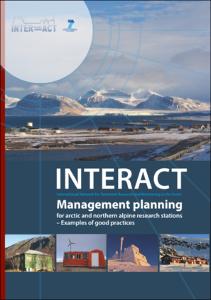| dc.contributor.author | Topp-Jørgensen, Elmer | |
| dc.contributor.author | Rasch, Morten | |
| dc.contributor.author | Elger, Kirsten | |
| dc.contributor.author | Vincent, Warwick | |
| dc.coverage.spatial | Arctic Region | en_US |
| dc.date.accessioned | 2022-02-02T15:49:28Z | |
| dc.date.available | 2022-02-02T15:49:28Z | |
| dc.date.issued | 2014 | |
| dc.identifier.citation | INTERACT (2014) INTERACT Management planning for Arctic and northern
alpine research stations – Examples of good practices. ( by Topp-Jørgensen, E. et al.).
Aarhus, Denmark, Aarhus University, DCE – Danish Centre for Environment and Energy, 324pp. DOI: http://dx.doi.org/10.25607/OBP-1713 | en_US |
| dc.identifier.isbn | 978-87-93129-09-2 | |
| dc.identifier.uri | https://repository.oceanbestpractices.org/handle/11329/1861 | |
| dc.identifier.uri | http://dx.doi.org/10.25607/OBP-1713 | |
| dc.description.abstract | This book is about management of arctic and northern alpine research stations. It has been
produced by a group of station managers participating in the EU 7th Framework Programme
Infrastructure project called INTERACT. With this book we want to share the knowledge and
experiences we have gained from managing very different research stations in very different
environmental and climatic settings. The target audience for the book is mainly managers of
research stations in arctic and alpine areas, but we hope that it will also be useful for others
involved in science coordination and logistics, e.g. research
institutions, chief scientists and expedition planners.
The book has been produced mainly based on input from
practising station managers being part of ‘INTERACT Station
Managers’ Forum (SMF), a forum established to provide a platform
for exchange of information between station managers and other
participants within INTERACT, and to collect and disseminate
knowledge embedded within the network.
The scope of this book is to identify and describe best practices
and key considerations of relevance to station management
under arctic and alpine conditions. As research stations operate
under very different legal regimes, financial conditions, environmental and climatic
conditions, as well as remoteness, it is not possible to identify specific best practices that fit all
stations. Instead, we have described key issues that should be considered and addressed by
station management, and supplemented this with examples of good practices from stations
operating under different conditions (e.g. different climate, remoteness or size).
The participating station managers have selected a number of themes that should be
covered by the book:
1. Management planning.
2. Policies.
3. Staff.
4. Visitors.
5. Permit issues.
6. Health and safety.
7. Environmental impact.
8. Outreach and marketing.
9. Research and monitoring.
10. Training and education.
11. Knowledge capture and data management. | en_US |
| dc.description.sponsorship | European Union, INTERACT | en_US |
| dc.language.iso | en | en_US |
| dc.publisher | Aarhus University, DCE – Danish Centre for Enviroment and Energy | en_US |
| dc.subject.other | Research station management | en_US |
| dc.subject.other | Management practicres | en_US |
| dc.subject.other | INTERACT | en_US |
| dc.title | INTERACT Management planning for Arctic and northern alpine research stations – Examples of good practices. | en_US |
| dc.type | Report | en_US |
| dc.description.status | Published | en_US |
| dc.format.pages | 324pp. | en_US |
| dc.description.refereed | Refereed | en_US |
| dc.publisher.place | Aarhus, Denmark | en_US |
| dc.subject.parameterDiscipline | Administration and dimensions | en_US |
| dc.subject.dmProcesses | Data acquisition | en_US |
| dc.subject.dmProcesses | Data archival/stewardship/curation | en_US |
| dc.description.currentstatus | Current | en_US |
| dc.description.sdg | 14.a | en_US |
| dc.description.eov | N/A | en_US |
| dc.description.adoption | Multi-organisational | en_US |
| dc.description.methodologyType | Guidelines & Policies | en_US |
| dc.description.methodologyType | Method | en_US |
| obps.resourceurl.publisher | www.eu-interact.org | |
 Repository of community practices in Ocean Research, Applications and Data/Information Management
Repository of community practices in Ocean Research, Applications and Data/Information Management
